Barra del Colorado Fly Tying Project
The fly-tying project was a huge success. I don’t know what I really expected, but the actual experience definitely surpassed all my pre-trip anticipation.
There was the logistics to deal with; this wasn’t like teaching a class in our local communities.
Damond and I did prep work for weeks in advance. We decided on a selection of patterns for tarpon and snook that we thought beginning tyers could handle. We chose patterns that started simple and got progressively more complex, while still being popular and effective for the fishing they do on the Rio Colorado. Since some of these patterns were new to us, we sat down and tied a few so we’d know what we were doing. (I did learn a couple new tying techniques that I’ll be incorporating into my flies.) I created step by step fly pattern sheets for each pattern, then translated them into Spanish. I pulled pages from my fly-tying manual about thread control, then modified and converted them to Spanish as well. We poured over a materials list for the flies, trying to balance cost verses quantity. Then we had to figure out how to pack all this stuff into the two suitcases each we’d be traveling with. I’ll share that both of us just squeaked under the 50lb mark on luggage, and our carry-ons were heavy; but we made it without any excess baggage charges.
However, we didn’t make it through Customs in Costa Rica. The vises, and an outboard steering unit Damond brought, flagged during the X-ray process and we got pulled out of line and asked for invoices on those items. Unfortunately, both items exceeded the allowable limit for import, and even though the vises were gifts, it was decided that they were subject to Costa Rican import tax. Which, by the way, would be decided later by another Government agency that we would have to deal with the next day. The short version of this story is that with a little help from our local contact, who was translating for us, we were able to pay the tax out of pocket for a piece of paper that allowed us to get our stuff out of lock-up. And it only took five hours instead of two to three days, which would have killed our timeline. We got lucky and learned a valuable lesson.
San Jose itself sits in a valley surrounded by mountains. However, like any big city, people and traffic are everywhere, and I would hate to navigate the through the barrios downtown without a GPS aid. Once out of the city and headed up through the mountains we saw some amazing landscapes, and since it was a four hour drive east to the river, we got to see some of the rural country side as well as we drove through some of the smaller communities.
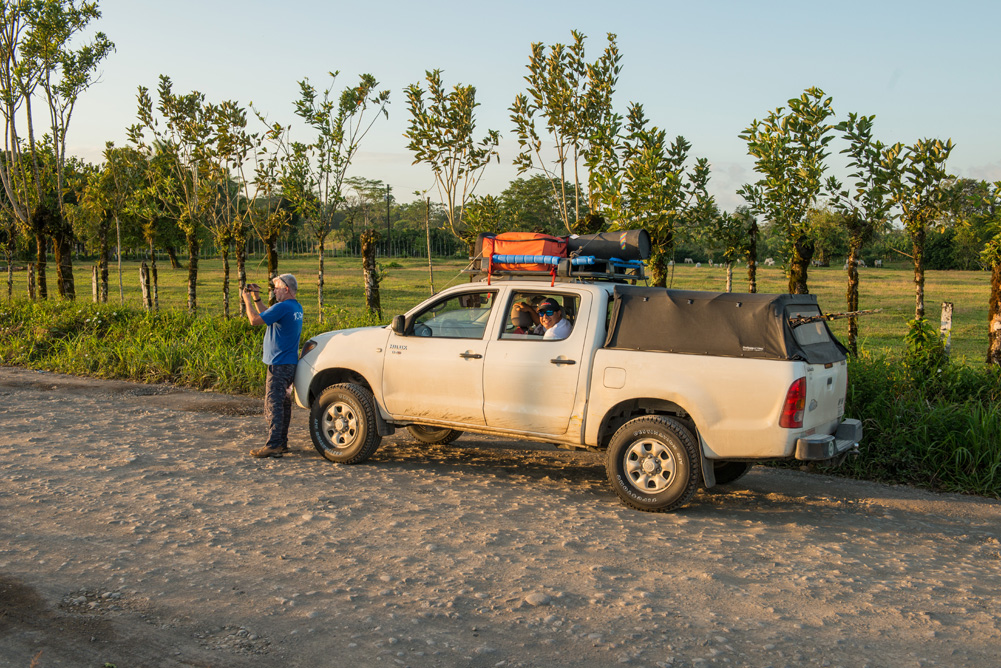
Due to our delay getting out of San Jose, it was dark by the time we reached the river for the ride downstream to Barra del Colorado. The captain of the transport boat wasn’t very happy about running the river at night, but Franko convinced him to get us to our final destination. The transport boat runs back and forth all the time, so the captain knew the river like the back of his hand. We couldn’t see much, but what was cool was the fireflies. They were twinkling in the trees along the shoreline as we slowly made our way down river. The river was low, so the captain idled over several sandbars. The trip downriver took almost an hour. I understand that it’s only about 30 minutes when the water is up, it’s daylight, and the boat can run under full power. Once at the lodge, we met our hosts, had dinner, and decompressed a bit. It had taken us two days of travel and had been an adventure up to this point, but we had made it!
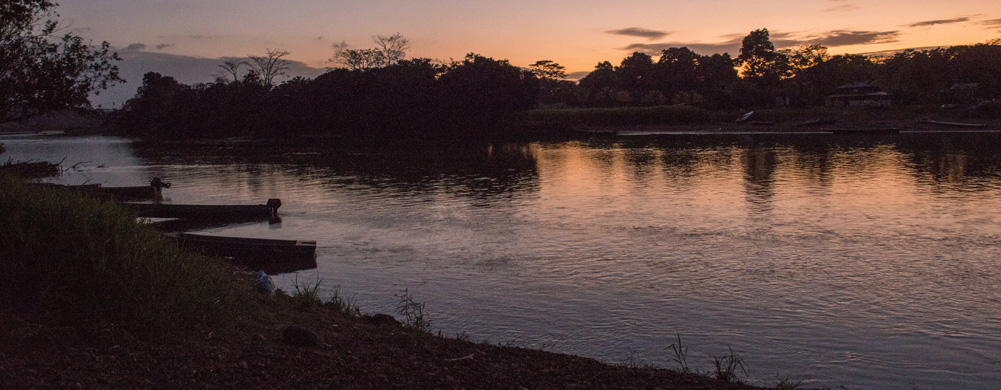
Brisas del Mar (Sea Breezes) was hosting the tying classes and owner Lorena had arranged for us to use part of her covered veranda as a classroom. Being in the tropics, this area is also the main dining, sitting, and social space. Outside of the guest rooms and kitchen area, the veranda makes up most of the covered area of the lodge.
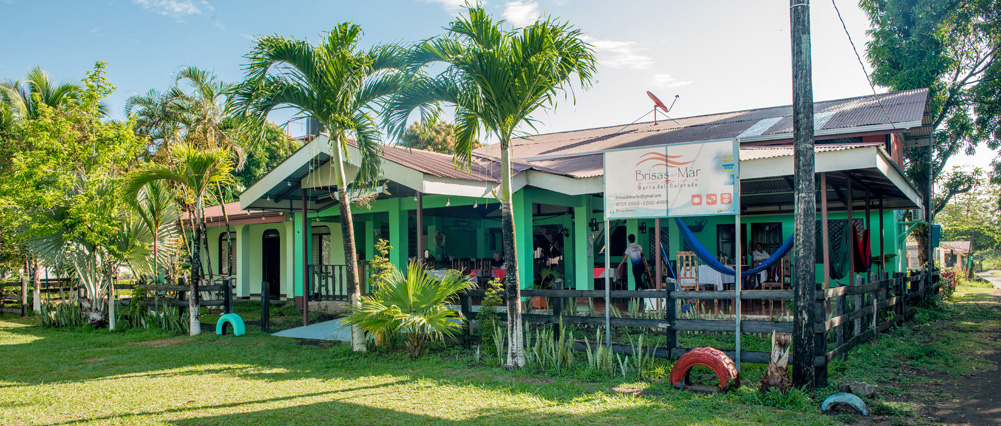
At the lodge, everyone is up early; anglers are off to their morning fishing as early as 6AM, and they’ve already been served breakfast by then. Since our classes started at 9AM, Damond and I slept in a bit, but spent time after breakfast prepping the tying area and sorting out materials. Once everyone started showing up, we realized that word of the tying classes had spread around the community and we now had twelve people interested in tying instead of ten. Nothing like being popular! To our rescue, one of the guest volunteered two of his (traveling) kits and we shared tools to make sure we could accommodate the extra people.

Like any class of beginners, it was pretty chaotic at first. Language was the biggest challenge. Fortunately, we had a couple of great translators. Franko (our primary contact in Costa Rica), Josue (a good friend of Franko’s), and Diane (an ex-patriot from Canada that lives in Barra) are bi-lingual and all had experience in tying flies. Between the fly pattern sheets, and someone translating what I was saying as I demonstrated techniques it went fairly well. Everyone would watch while I demonstrated, then return to their vises to duplicate what they had seen. With one-on-one help with students from Damond, Franko, and myself by the end of the first session that morning, we had tied the first two of the patterns on the list. Lunch break… for two hours! In Barra they seem to do a leisurely lunch. Anglers come back from their morning fishing and a hot lunch is served. Then everyone seems to just chill for a bit. Naps I would assume, but don’t know as we were busy prepping for the afternoon session that started at 2PM.
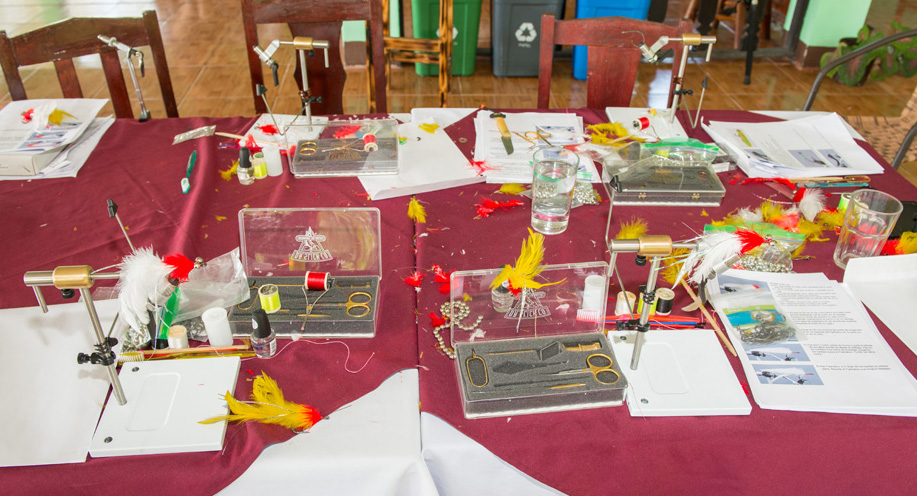
It was during the afternoon session that we started seeing the interest level kick up a bit. Students were asking for help with techniques they were struggling with. There was more interaction between the tyers as they helped each other. And everyone seemed to be having more fun with the process. It was encouraging to see the effort they were putting into each step as we pushed through a couple more patterns that afternoon. The three-hour class went by fast, and by the end of the first day the students with natural skills, and the ones with the drive for doing it “right”, were starting to show themselves. It was a good day!

That evening there was a bit of casting practice in front of the lodge and a cold beverage or two before dinner. We got to officially meet the anglers staying at the lodge; a group of three from France and a couple from Argentina. The guys from France were mostly gear anglers, but Daniel from Argentina was a fly fisher. Not only did we have an opportunity to talk fly fishing, but I learned a simple foam rubber-leg bug pattern from him that I incorporated into the next day’s tying class. Seems that Costa Rica has a few freshwater species that, although not as popular as the tarpon and snook, can be a lot of fun on a lighter rod. We stayed up way too late visiting; but hey, we figured we could rest when we got back home.
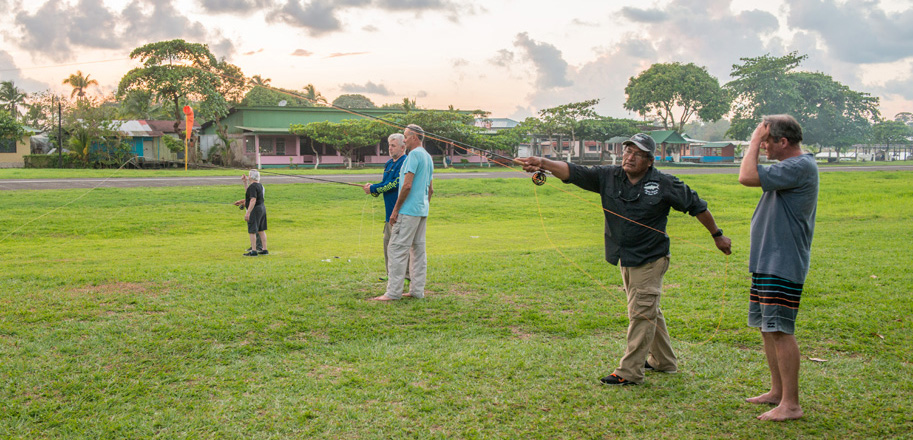
Day two – Intermediate level flies. Everyone showed up on time and ready to learn. The first thing Damond I did was teach the students how to do a whip finish with their fingers. We’d been using the whip-finish tool the first day, but Damond had brought his “sticks with strings” and the students had the technique down in no time. By the end of the morning session, we had four more patterns tied, including the foam bug I had seen the night before. Skill levels in individuals were really starting to develop and students helping students was common. You could almost see the excitement as their flies appeared in their vices.
The afternoon session only included two patterns, but both flies used unique tying techniques and we spend a fair amount of time going over the skills in-depth. Apart from material bulk, I have to say I was very impressed with the quality of the construction from all the students as they finished their last pattern. As an outsider, both in language and culture, it was hard for me to gage how much they recognized my praise; but I did try to let them know that as a groups of beginners, I had never seen so much improvement in such a short amount of time. They all worked hard at learning the skills we had come to teach.
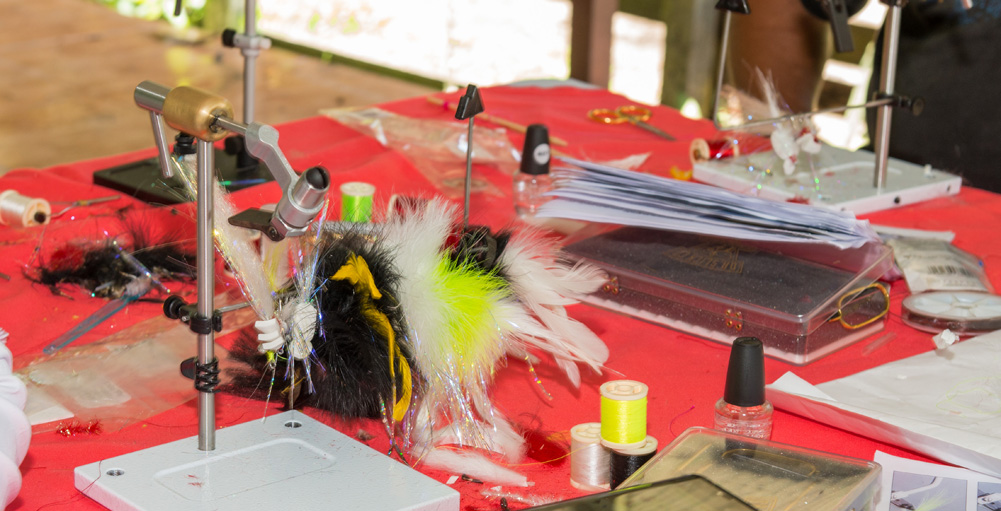
So, as I said in the beginning, I’m not sure what I expected, but the project went well past what I was hoping for. The project created excitement within the community of Barra; we had a fishing skipper (Cliff) volunteer to spend his time with students interested in continuing to develop their tying skills (Come to find out, he ties a pretty mean fly himself and showed us a box that he has for his clients. Good flies!); we were told that at least two of the students expressed interest in tying for retail sales and will be coached by Diane (mentioned earlier) in business skills and marketing outside of the local fishery; everyone kept expressing how grateful they were that we came down to teach and how much they had learned.
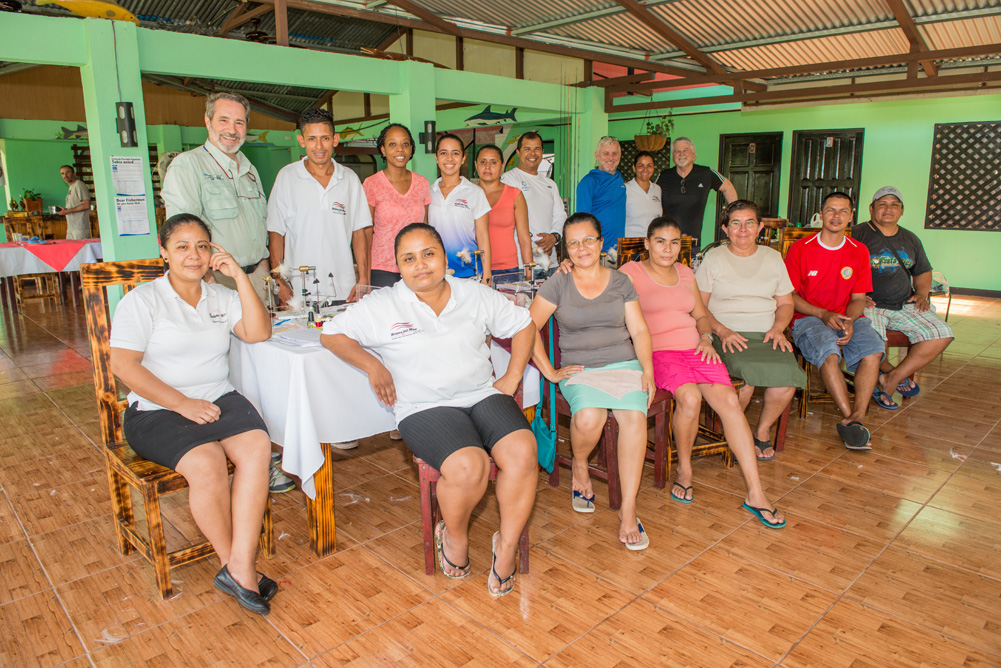
It was decided that the equipment and extra materials would be kept at the lodge for any of the tyers to use on an as needed basis. They are going to run it like a co-op, with all the people who participated able to check out what they need to practice and/or tie flies with. Franko will stay in touch with Lorena to make sure they keep the equipment up and arrange materials as needed. (Franko lives in San Jose and has better access to tying materials.) I hope to make it back to Barra in the near future; to fish mostly, but to also check in and see how our kick starter project does in the long run. Hopefully we have made an impact and influenced the future of some lives through this project.
An extra loud shout out to the following that helped us make this project a reality.
Alaska Fly Fishers – Mossy Fly Shop – Peak Vises – Brisas del Mar Lodge – Franko Avarenga, our Costa Rican host, and everyone who contributed to our Go Fund Me account. This project would not have happened without you.
Some parting notes:
We did have an opportunity to fish for a day. However, the weather turned on us and temperatures dropped 10 to 15 degrees. When that happens, the fish go down and there is no bite. So, we spent the day “fishing”, not catching.
The day we left, we got out for about three hours in the early morning. The temperatures had come back up and Damond & I managed to hook a couple of Jack Carvalles on fly rods, and Josue (on our boat) hooked a couple tarpon casting jigs. Damond jumped one tarpon on the fly rod, but it threw the fly on its first jump. Saul (on another boat) lost one of the biggest tarpons of his life drifting a fly just inside of the river mouth. Tarpon do seem like flies!
The more we visited the more we learned that there’s lots more to Costa Rica fly fishing than saltwater. There is plenty of freshwater habitat for Machaca, Guapote, and Mojarra; all of which will come to fly patterns and are great sport on lighter rods. On our next opportunity to go down, we’re planning on exploring those options as well.
Talkeetna River: Cubed – May 18, 2017
I wrangled an unprecedented opportunity to fish the Talkeetna River for the third time this spring. All the factors that control my fishing life came together in a prefect union. Although mostly it was the fact that the weather has been cooler this month, the water quality/clarity on the Talkeetna has remained good, and my brother could go. Lance was committed to a work trip to Ninilchik; bummer.
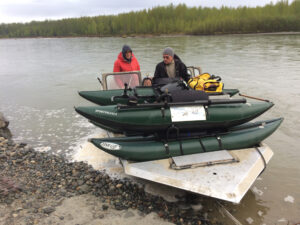 Worst part about this trip was the 7AM launch time. It was a really early morning for both of us but we did well, and by 7:10 we were loaded on Jerry’s boat ready for the trip up to Clear Creek. We had decided to start a little lower than we usually do as we had been much more successful below Clear Creek than above it the last two trips. We wanted to save the couple of hours we usually spend upriver concentrating on the confluence area. We ended up running up Clear Creek a little ways to launch.
Worst part about this trip was the 7AM launch time. It was a really early morning for both of us but we did well, and by 7:10 we were loaded on Jerry’s boat ready for the trip up to Clear Creek. We had decided to start a little lower than we usually do as we had been much more successful below Clear Creek than above it the last two trips. We wanted to save the couple of hours we usually spend upriver concentrating on the confluence area. We ended up running up Clear Creek a little ways to launch. 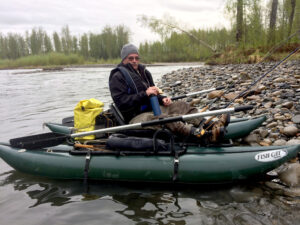 That gave us a chance to fish it in a couple of spots before dropping down to the confluence. I caught a mid-teens rainbow in Clear Creek and we saw a few rises which I later figured out were probably small grayling.
That gave us a chance to fish it in a couple of spots before dropping down to the confluence. I caught a mid-teens rainbow in Clear Creek and we saw a few rises which I later figured out were probably small grayling.
My fishing karma must have kicked in this trip as a few times during the day we pulled up to fish an area and I was into a fish within a couple of casts. Twice it was on the first drift through a run. This is the sort of thing than can frustrate your fishing companions, especially when they aren’t getting any “fish love” themselves. Read the rest of this entry »
Talkeetna River: Redux – May 7, 2017
It’s eleven days later and we’re up on the Talkeetna again; only this time Lance was able to make the trip as he’s back from conference and it’s a Sunday. However, the word is out, and it is a weekend in Alaska, so even with a meet time of 8AM we see friends at the launch, and hear that anglers have been on the river, doing well, all morning. Seems 8AM isn’t really early enough in the fishing world.
Jerry with Talkeetna Fishing Guides runs upriver to the same spot as last trip, only this time its most beach, with very little ice left on the bank.
First Trip – April 26, 2017: Talkeetna River
Early for Alaskan waters, but I had got word from a friend that Jerry Sousa of Talkeetna Fishing Guides had put his boat in the river Sunday, the 23rd, and had been able to run the jet upriver to Clear Creek. Good news for those of us with Spring Fishing Fever. A phone call Monday morning confirmed a drop off trip on Wednesday for my brother Dennis and myself; Lance was trapped at a conference in Vegas until Thursday and was going to missed this opportunity (we don’t talk about it).
The Talkeetna River is one of the two rivers than can provide some decent spring fishing in south-central; the other being the Kenai. The Kenai River is road accessible and had been seeing anglers for most of the month in its upper reaches below the lake. We wanted to test the Talkeetna as it is much harder to access, receives much less pressure, and therefore more apt to fish better; if the water is decent. That’s the risk with the Talkeetna; it doesn’t flows from a lake like the Kenai and is very susceptible to runoff, water level fluctuations, and turbidity depending on the weather and runoff. It’s a roll of the dice. Read the rest of this entry »
Spring Fishing – Plan D: A Friend of a Friend
So it’s mid-April and we’re having an extremely early and warm spring this year. Coupled with a very mild winter, this means that spring fishing is at least 3 weeks early and we are already seeing signs that if we don’t get out soon, the rivers are going to silt up with runoff and high water. Our challenge is that the river boat operator that we usually hire to run our rafts up the river we like to fish in early spring is out of state until May and we don’t have that much time. Lance is saving up vacation time for June when his brother is coming to Alaska, so fishing needs to happen on a weekend. Due to my schedule, I have only one open weekend, the 23rd of April, which is before Rhett at Phantom Charters will be back. What now?
Kenai Lake Outlet & a follow-up on our Flying Rafts
Two weeks have gone by since losing our rafts off the trailer (see Flying Rafts post). Lance & I are headed back down to the outlet of Kenai Lake to fish. My raft has been repaired from the road rash holes, I have invested in tie-down straps with locking clips, and we came up makeshift side bars that allowed Lance to check if the rafts were still on the trailer from his side mirrors. We stopped and checked everything a couple of times during the 100 mile run to the river. Mostly because we were a bit gun shy after the last trip. Everything held tight.
Flying Rafts
This blog was supposed to be so much different than it is, but (BLEEP) happens!
We were going to fish the Upper Kenai again this weekend. Only this time we were planning on staying in the lake above the bridge and the slow section of the river just below. Reports were that, although there were fish being caught down in the upper river, this section was producing well. Besides, after last Friday’s adventure of getting off the river at dark-thirty, we wanted to be within an easy row of the truck and trailer. Lance and I had decided to take our flippers and slow troll our flies back and forth across the outlet banks. We felt that even below the bridge, the current was slow enough that flippers would allow us to cover the water much like we do in lakes. And, if we needed to, we could just get our feet up on the pegs and row out of any faster current. My brother Dennis decided to take his electric motor and Hummingbird fish/depth finder. He had tried the fish finder a few years earlier while floating the main river and it didn’t work well. He was pretty sure that at least he would be able to find the ridge line that defined the shallower water just up from the bridge from the much deeper hole a bit up into the lake. Saturday worked for all three of us, so we planned for a 9:00AM “Get out of Dodge” departure. Surprisingly, we were loaded and away from the house about 10 minutes ahead of schedule. Read the rest of this entry »
Earliest 1st Trip Ever
The First Day of Spring in Alaska is usually acknowledged with an understanding wink between those of us that live here, as we know “spring” is still four to six weeks away.
However, this year we’ve had an unbelievably mild winter, and with virtually no snow and lots of day time temperatures in the low 40’s Lance & I decided we needed to go fishing. Besides, a fishing trip is good for what ails you.
I had driven to Homer on March 5th and the Upper Kenai was as low as I’ve ever seen it. No bank ice, clear water (for the Kenai) and a spurt of late run Silvers that arrived in the upper river in really late, all promised for as good of fishing as you could hope for. Now we were not after the Silvers; the season for them is closed, but where there’s spawning salmon you can be sure there will be Rainbows, and since we were going to be by the lake, possibly Dolly Varden.
As luck would have it, Friday March 20th was the earliest day we could get together that the temperatures were going to be near the 40 degree mark; the First Day of Spring. This would be the earliest first trip of the year I had ever been on, and by no small margin. However, as usual, Murphy started to mess with us. (Murphy is a regular on lots of our fishing excursions. He seems to just invite himself.) Lance ended up with a doctor’s appointment first thing Friday morning. No biggie, we’ll just leave later; that will give the day time to warm up. Dennis discovered a leak in one of his tubes Friday night and can’t find his patch kit. Ok, off to Alaska Raft for a patch kit (and some advice about the fishing at the bridge because the guys at AK Raft are like that). I had friends that came in from Nome Thursday afternoon and back off to Texas at 3:00AM Friday morning. Deal with it; a couple of short naps are way better than no sleep.
But as it turned out we were buying sandwiches at Subway just after 12 Noon, and didn’t get onto the water until about 3PM. Read the rest of this entry »
Fly Fishing Festival & Spey Clave
Up Coming Event
Saturday, August 16th at Mirror Lake Park
The 2014 Fly Fishing Festival and Spey Clave
sponsored by the Alaska Fly Fishers and Fish Alaska Magazine.
Click the link below to go to AFF’s Facebook event page.
https://www.facebook.com/events/740018756039241/?ref_dashboard_filter=upcoming
More Lessons from a Lake Master
Lance and I fished with Lake Master Mike Malone again, and like our last outing, we let Mike pick the destination. This time we headed north of Wasilla on a Sunday; which turned out to be a very pleasant day, given the forecast was for rain. It was a short (fishing time) day trip with a lot of driving attached. Lance and I had been to this particular lake before, about 15 years ago; with Mike, his son Tim, and a mutual friend Greg Heister. We fished small Lake Leeches back then, and I don’t remember the day being nearly as nice. I seem to remember cool drizzly skies. I do know we did not catch nearly as many good fish. (In fact, I think I went fishless.) Today’s trip was different. Read the rest of this entry »







